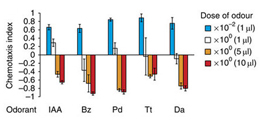Research Abstract
線虫で見られる匂い物質の濃度に依存した嗜好性の変化
Odour concentration-dependent olfactory preference change in C. elegans
2012年3月13日 Nature Communications 3 : 739 doi: 10.1038/ncomms1750

ヒトなどのさまざまな動物で、同一の匂い物質が、その濃度によって誘引性あるいは忌避性の応答を引き起こすことがある。しかし、この行動の神経基盤についてはほとんどわかっていない。本論文では、低濃度では線虫(Caenorhabditis elegans)の誘引行動を引き起こす匂い物質が、高濃度の場合には忌避行動を引き起こすことを明らかにした。行動解析とコンピューターシミュレーションから、匂い物質の濃度に依存したこの行動は主に、線虫の行動戦略の1つであるクリノキネシス(変向無定位運動性)により調節されていることがわかった。遺伝学的解析および神経破壊実験から、匂い物質に対して機能する感覚ニューロンの組み合わせが、匂い物質の濃度によって異なることが示された。AWC感覚ニューロンは匂い物質に対する誘引行動に、ASH感覚ニューロンは忌避行動にそれぞれ重要である。さらに、AWCニューロンは匂い物質が低濃度の場合にだけ、一方ASHニューロンは高濃度の場合にだけ応答することも明らかになった。したがって、今回の結果は、線虫における匂い物質の濃度情報のコードは、種類の異なる刺激に対してはそれぞれ別々のニューロンが応答するというラベルドライン説(占有回線説)におおむね従っていることを示唆している。
- 東京大学大学院 理学系研究科 生物化学専攻
- 九州大学大学院 理学研究院 生物科学部門
- 岩手大学 工学部 応用化学・生命工学科
The same odorant can induce attractive or repulsive responses depending on its concentration in various animals including humans. However, little is understood about the neuronal basis of this behavioural phenomenon. Here we show that Caenorhabditis elegans avoids high concentrations of odorants that are attractive at low concentrations. Behavioural analyses and computer simulation reveal that the odour concentration-dependent behaviour is primarily generated by klinokinesis, a behavioural strategy in C. elegans. Genetic analyses and lesion experiments show that distinct combinations of sensory neurons function at different concentrations of the odorant; AWC and ASH sensory neurons have critical roles for attraction to or avoidance of the odorant, respectively. Moreover, we found that AWC neurons respond to only lower concentrations of the odorant, whereas ASH neurons respond to only higher concentrations of odorant. Hence, our study suggests that odour concentration coding in C. elegans mostly conforms to the labelled-line principle where distinct neurons respond to distinct stimuli.

